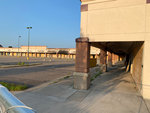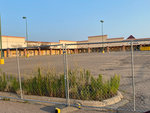


Redevelopment of the Midway Center superblock, including the burned-out remnant of Midway Center, is moving ahead with changes to a tax increment financing (TIF) district and an order to demolish the remaining section of Midway Center. But when demolition and development will happen are still unknown.
On a 6-1 vote Aug. 25 the St. Paul City Council approved a new redevelopment TIF district for the old shopping center property. The agreement makes about $209 million available in TIF, replacing an agreement that made $112 million available.
Council members Nelsie Yang, Chris Tolbert, Dai Thao, Rebecca Noecker, Mitra Jalali and Amy Brendmoen voted for the agreement; Jane Prince voted against.
The council also unanimously and without comment ordered that the shopping center’s fire-damaged east wing be razed and removed in 15 days, with no option for repair. A nearby burned-out building that housed Big Top Liquors was torn down in August. Both buildings were looted and set ablaze in the May 2020 unrest after the murder of George Floyd.
Removal of the building could take longer than 15 days. As of the Monitor deadline no demolition permit had been pulled. The property owners have indicated they want to use the site for parking for a time, which has irked neighbors who’d rather see redevelopment.
The TIF agreement indicates that redevelopment is to start in late 2021 or early 2022. The development is expected to be completed by Dec. 31, 2031 with an expected market value of approximately $514,207,500.
TIF subsidizes development by diverting a portion of increased property taxes to uses such as infrastructure. St. Paul recently has focused on using TIF to help pay for affordable housing. Excess TIF from Highland Bridge development in Highland neighborhood is also eyed for use for affordable housing citywide.
Use of TIF requires meeting standards that development would not occur without the funding source, which is called the “but/for” test.
Area residents have clamored for redevelopment of the longtime Midway Center block since an ambitious master plan was unveiled in 2016. The Allianz Field Major League Soccer stadium opened in 2019.
The most recent plans for the site, unveiled in spring 2020 by Snelling Midway Redevelopment LLC, were the United Villages at Midway. The proposed development would include two new towers with 243 apartments, 15,780 square feet of retail and office space and 148,470 square feet of parking. That would be located on the western part of the property.
New district outlined
The TIF agreement approved Aug. 25 doesn’t name a developer. The city has a demolition and development agreement with property owner RK Midway and with Snelling Midway Redevelopment LLC. Snelling-Midway Redevelopment LLC is a partnership with lead Minnesota United soccer team owner Bill McGuire and the shopping center owners.
The new Snelling-Midway district replaces a “renewal and removal” district approved by the council in November 2020. The original district was established to preserve the TIF option while a redevelopment district was explored as an option.
Melanie McMahon, who leads major development projects for the city, said the TIF change provides a greater ability to pool money for affordable housing citywide. McMahon also said that the city council and Housing and Redevelopment Authority (HRA) will need to take additional actions in the future to set up the district.
Council members who support the change said the action gives an option while allowing for specifics later. Thao, whose First Ward includes Midway Center, said the change preserves an important tool for redevelopment.
Prince said she doesn’t believe the change was brought forward in a transparent manner. She said the $209 million reservation of TIF is $94 million more than what was put into place last year.
She noted the potential loss in property taxes to Ramsey County and St. Paul Public Schools that a TIF district would create. Over 26 years the school district would not receive $54.9 million, the county would not receive $65.9 million, and the city would not receive $67.9 million.
Prince also questioned the redevelopment plan, which calls for one million square feet of office space, 421,100 square feet of retail space, 400 hotel rooms and 620 housing units. About 30 percent of the housing units would be affordable, although the TIF agreement doesn’t spell out levels of affordability.
The plan also includes about 4,500 structured parking spaces, down about 200 spaces from previous plans. Prince commented on the irony of building so much parking right after the city abolished parking minimums.
“The only thing I feel good about is that we’re building affordable housing,” she said.
A market study is needed to see what development is feasible on the site, said Prince, given the office and retail changes spurred by the COVID-19 pandemic. She questioned what downtown leaders would think, given so much vacant office space downtown.
Deputy Mayor Jamie Tincher and other council members pushed back at Prince’s comments. Noecker, who voted against a past version of the TIF district several years ago, said she shares concerns with Prince. But Noecker added that there still is time to study the TIF district and redevelopment plans, and do community engagement.
Redevelopment districts are desirable for developers because they can be in place longer, for up to 26 years. The district replaced had a 16-year life span. A redevelopment district also allows for increments not needed for site redevelopment to be used for affordable housing citywide.
In June 2020 the council, acting as the HRA Board, took initial steps toward a redevelopment TIF district. The HRA found that buildings on the property are substandard, which is a finding needed to create the district.
“It is important to note that this procedural step at city council only approves the establishment of the TIF District and does NOT authorize any funding for any developer or project on the site. The HRA Board would also need to approve the establishment of the TIF District. In order to grant TIF assistance to a developer, a developer request would need to be thoroughly examined by the HRA, a development agreement would need to be negotiated and reached, and that development agreement would need to come to the HRA Board for public discussion and a vote to approve,” a staff report stated.
Comments
No comments on this item Please log in to comment by clicking here